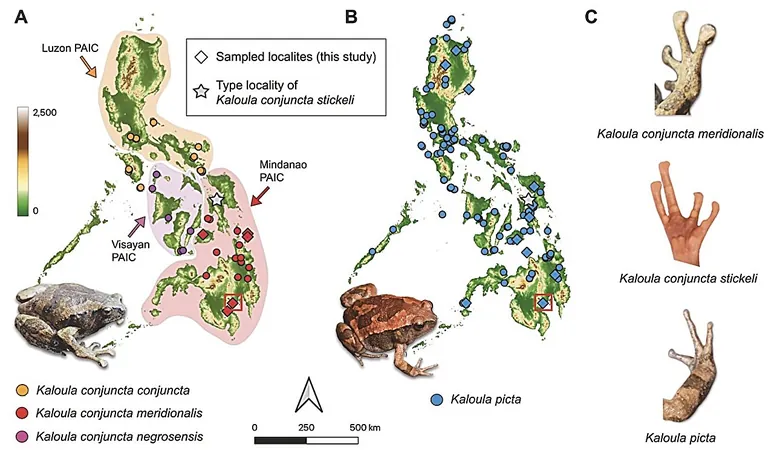
The Mystery of the Leyte Chorus Frog: After 80 Years, Scientists Unravel its Hybrid Origins!
2025-03-26
Author: Wei
Introduction
Evolutionary biologists have finally cracked the code of a long-standing riddle in the world of amphibians: the Leyte Chorus Frog. This rare species, found on Leyte Island in the Philippine archipelago, has eluded researchers since its discovery in 1944. Its unique toe pads and elusive nature prompted extensive searches, yet it remained a ghost in the world of herpetology for decades.
Breakthrough Research
New groundbreaking research from the University of Kansas, published in the journal Heredity, reveals that this enigmatic frog, known scientifically as Kaloula conjuncta stickeli, is not just any ordinary amphibian; it is a hybrid formed from two different species. The intermixing of these frogs is believed to have been exacerbated by deforestation, which has drastically altered their habitats, pushing different species into closer contact than ever before.
Unique Characteristics
Lead author Chan Kin Onn from KU's Biodiversity Institute explains, "This frog is unique and has puzzled scientists for years. When we first examined it, it was noted for its distinct appearance. However, the real mystery was in its rarity – only a handful of specimens have ever been collected."
Specimens and Classification Challenges
Despite years of dedicated research, only seven specimens of the Leyte Chorus Frog exist globally, making genetic analysis tricky. The initial collection, which yielded only two frogs, left scientists questioning whether it was a legitimate subspecies or something much rarer. In reality, it seemed to reside in a grey area of classification, with hypotheses ranging from it being a subspecies to fears of its extinction.
Insights from Fieldwork
Discovering specimens from southern Mindanao, Brown's fieldwork has shed light on this hybrid phenomenon. "It has been a nagging question for me since I first encountered these frogs," he admitted. "What they represent has always been a mystery."
Genomic Analysis
Using advanced genomic analysis, Chan and his team uncovered that the Leyte Chorus Frog is the F1 hybrid offspring of Kaloula conjuncta meridionalis and Kaloula picta. Interestingly, these parent species inhabit different environments – one prefers treetops while the other adheres to the ground. However, the loss of habitat due to logging created scenarios where these two species could interact and breed, leading to their unexpected hybrid offspring.
Morphological Traits
"This hybrid is fascinating because the parent species exhibit such different traits," Chan stated. "One has large toe pads adapted for climbing, while the other has minimal toe pads, suited for a terrestrial lifestyle. The Leyte Chorus Frog shows an intermediate morphology—its toe pads are a blend of both parents."
Challenges and Genetic Barriers
However, this hybrid frog faces significant challenges. It appears to be an evolutionary dead end. Chan suspects that genetic incompatibilities arise during breeding, preventing the hybrids from reproducing further. "They cannot progress beyond the initial F1 generation," he explained, alluding to future studies that may confirm these genetic barriers.
Importance of Museum Specimens
Brown highlighted the importance of museum specimens in resolving biological mysteries. "Chan's academic prowess and the quality of genetic data have brought closure to the Leyte Chorus Frog saga," he remarked. "We owe a debt of gratitude to the early researchers who meticulously preserved these specimens, allowing today’s scientists to unlock such secrets."
Conservation Concerns
As conservation issues loom over the Philippines, the hybrid nature of the Leyte Chorus Frog serves as a reminder of the fragility of biodiversity. With continued habitat destruction, this frog’s story sheds light on the urgent need for conservation efforts in the face of environmental change. Could this be a warning sign about the future of many other species as their habitats continue to dwindle? Only time will tell.


 Brasil (PT)
Brasil (PT)
 Canada (EN)
Canada (EN)
 Chile (ES)
Chile (ES)
 Česko (CS)
Česko (CS)
 대한민국 (KO)
대한민국 (KO)
 España (ES)
España (ES)
 France (FR)
France (FR)
 Hong Kong (EN)
Hong Kong (EN)
 Italia (IT)
Italia (IT)
 日本 (JA)
日本 (JA)
 Magyarország (HU)
Magyarország (HU)
 Norge (NO)
Norge (NO)
 Polska (PL)
Polska (PL)
 Schweiz (DE)
Schweiz (DE)
 Singapore (EN)
Singapore (EN)
 Sverige (SV)
Sverige (SV)
 Suomi (FI)
Suomi (FI)
 Türkiye (TR)
Türkiye (TR)
 الإمارات العربية المتحدة (AR)
الإمارات العربية المتحدة (AR)